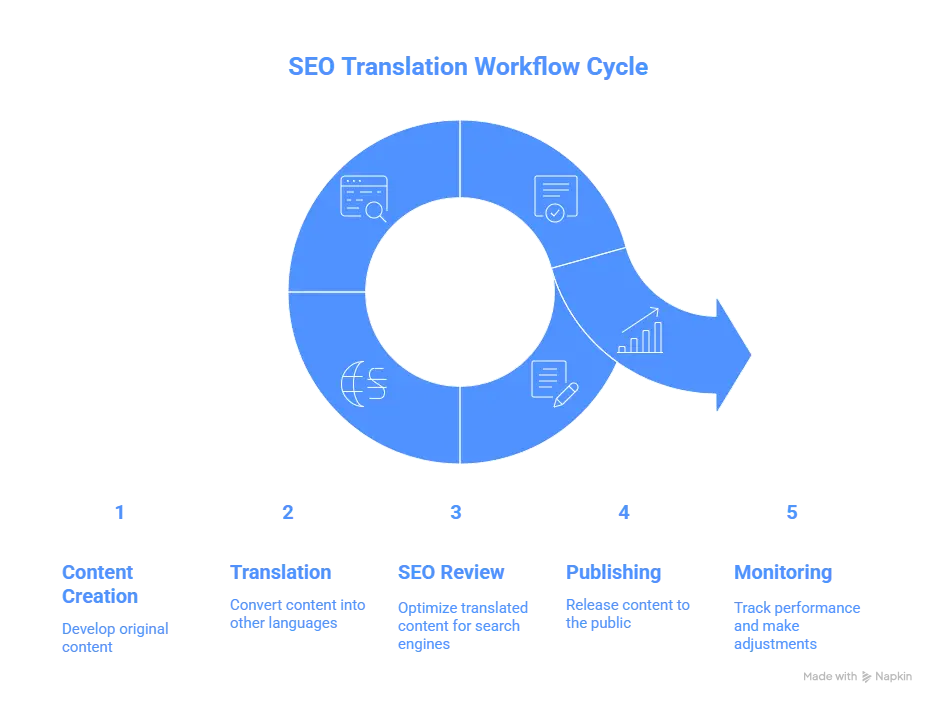

Key takeaways:
- Translate keywords based on local search intent, not word-for-word
- Localize titles, meta descriptions, slugs, and alt text for each market
- Implement a clear URL strategy and correct hreflang setup
- Build a repeatable translate → SEO review → publish workflow
- Track rankings, traffic, and conversions by language to prove ROI
- Use Geo Targetly’s Geo Translate to deliver translated content on one URL and keep your SEO structure intact
SEO translation makes your content discoverable and persuasive in every market you target. It goes beyond converting words - aligning keywords with local search intent, translating metadata and URLs, and using the right technical signals so each version can rank.
When your translations are optimized, they rank in local SERPs and bring in visitors who are ready to buy.
What is SEO translation?
SEO translation adapts your website content so it ranks and converts in another language. It’s more than word-for-word translation, it pairs native keyword research with translated on-page elements, metadata, and URLs, plus the technical pieces like hreflang and structured data.
Instead of just translating text, you’re matching how local users search and how search engines understand content in that market.
Why SEO translation matters
Search behavior is local. More than 70% of internet users spend most or all of their time on websites in their own language, yet many brands still rely on English-only content. That means they’re invisible in non-English search results, even if the product is relevant.
Localized content doesn’t just attract traffic. It converts better, too. Research from OneSky and Ulatus shows that localized websites can see up to 47% more search traffic and 2-3x higher conversion rates than non-localized versions.
In short, SEO translation helps your content compete in local SERPs, reach audiences in their language, and turn that global visibility into measurable growth.
Core elements of SEO website translation
Strong SEO translation covers more than text. Every visible and invisible element of a page, from the title tag to the date format, sends signals to both users and search engines. Here’s what to focus on.
On-page elements
These are the parts visitors see first, and where local intent matters most.
Headings, body copy, and calls to action should sound native while naturally including localized keywords. Internal links and button text need translating too.
“Buy now” may become “Acheter” in French or “Jetzt kaufen” in German, depending on the tone. The goal is to make each page read as if it were written for that audience from the start.

Metadata and URLs
Behind the scenes, metadata and URLs help search engines understand and rank each localized version.
Translate title tags, meta descriptions, and image alt text with local keywords, and rewrite URL slugs into clean, readable phrases.
For instance, use /de/produktname instead of /en/product-name. These small adjustments improve click-through rates and reinforce language targeting.
Structured data and schema
Structured data tells search engines exactly what a page contains. Translating schema fields like “name” and “description,” and including locale attributes such as inLanguage or priceCurrency, ensures your localized content appears correctly in rich results.
Always test with Google’s Rich Results tool after updates.
UX elements
User experience also plays a big role in SEO. Translate and localize details like numbers, dates, currencies, and measurement units to match local conventions.
Colors and imagery can carry cultural meanings too – what feels energetic in one country may seem aggressive in another. Consistency between language and experience builds trust and keeps visitors engaged.
Quick checklist: what should be translated for SEO
- Page titles, headings, and body text
- Meta descriptions and URL slugs
- Image alt text and captions
- Structured data fields and schema attributes
- Navigation menus, forms, and buttons
- Dates, currencies, and local contact info
Keyword research across languages
Translating keywords isn't the same as translating content. Direct translations often miss the way people actually search in different regions. Effective SEO translation starts with understanding how search behavior varies across languages, dialects, and cultures.
Adapting keywords for local SEO
Keyword translation is rarely one-to-one. A term that performs well in English might have multiple equivalents in another language, each with different search volumes and competition levels.
Let’s say you’re translating a page about “email marketing software” into German. A direct translation might give you “E-Mail-Marketing-Software,” but native keyword research might reveal that “Newsletter Tool” has higher search volume and stronger commercial intent in Germany.
Effective SEO translation includes:
- Running keyword research in the target language using local tools (like Google Keyword Planner set to the region)
- Comparing search volume, competition, and relevance
- Choosing keywords that align with both your content and local behavior
- Analyze local competitors’ websites and the keywords they rank for
- Work with native speakers or local SEO consultants to validate phrasing and intent
This process helps you avoid wasting time optimizing for terms no one is actually searching.
Map keywords to local intent
Once you have a list of localized keywords, the next step is mapping them to the right pages and content types. This is where intent comes into play.
A German user searching “beste Kaffeemaschine 2024” (best coffee machine 2024) is likely in the research phase. That keyword belongs on a comparison or review page.
On the other hand, “Kaffeemaschine kaufen” (buy coffee machine) signals purchase intent and should point to a product or category page.
Create an intent map for each language that includes:
- Informational keywords (how-to, reviews, comparisons)
- Navigational keywords (brand or product-specific)
- Transactional keywords (buy, order, pricing)
This helps avoid mismatches between search intent and landing pages, which can hurt both rankings and conversions.

Use translation tools carefully
Machine translation tools like Google Translate or DeepL can help you get started, but they’re not built for SEO. They don’t account for keyword density, search intent, or regional variations.
Instead, use them to generate a draft list, then refine with:
- Native speakers or bilingual SEO professionals
- Local keyword research tools like SEMrush, Ahrefs, or Ubersuggest with country-specific filters
- SERP analysis in the target language to see what’s actually ranking
Technical SEO considerations
Good SEO translation depends on more than the words on the page. The way your site is built and organized affects how search engines crawl and rank your translated content. If the technical setup is off, even strong translations won’t perform well.
Here’s what to focus on to keep your multilingual SEO running smoothly, from URL structure and hreflang tags to crawl efficiency.
Structuring URLs for multilingual content
Search engines need clear signals to understand which version of a page is meant for which audience. Your URL structure is one of those signals.
There are three common approaches:
- ccTLDs (country-code top-level domains): example.fr, example.de
- Subdirectories: example.com/fr/, example.com/de/
- Subdomains: fr.example.com, de.example.com
Each has trade-offs. ccTLDs are strong geo signals but require separate domain authority. Subdirectories consolidate SEO value under one domain, which is easier to manage. Subdomains fall somewhere in between but can dilute authority if not handled carefully.
For most teams looking to scale efficiently, subdirectories strike the right balance between SEO performance and operational simplicity.
Implementing hreflang tags correctly
Hreflang tags tell search engines which language and regional version of a page to show users. Done right, they prevent duplicate content issues and improve relevance in search results. Done wrong, they confuse crawlers and hurt rankings.
Here’s what to keep in mind:
- Use the correct language and country codes (e.g., en-us, fr-fr, es-mx)
- Include self-referencing hreflang tags on each page
- Make sure each version links to every other version (full cross-referencing)
- Place tags in the <head> section or via HTTP headers for non-HTML content
Managing crawlability and indexing
Search engines have limited resources to crawl your site. If you’re adding dozens of localized pages, you need to make sure they’re discoverable without overwhelming your crawl budget.
Start by:
- Submitting updated sitemaps with all translated URLs
- Using canonical tags to point to the correct language version
- Avoiding automatic redirects that block crawlers from accessing alternate versions
- Monitoring crawl stats in Google Search Console for anomalies
Also, don’t forget internal linking. Link between language versions where it makes sense, and use language switchers that are crawlable, not JavaScript-only dropdowns.
Scaling SEO translation efficiently
As your site expands into new markets, translating everything manually stops making sense. You need a process that keeps search intent, keyword accuracy, and technical consistency intact across every language.
Build a scalable translation workflow
Start by centralizing your translation process. Use a translation management system (TMS) that integrates with your CMS and supports SEO metadata fields like title tags, meta descriptions, and alt text. This ensures nothing gets missed and helps your team move faster.
Next, define clear roles. For example:
- Marketers handle keyword research and content prioritization.
- Translators focus on language accuracy and cultural relevance.
- SEO specialists review keyword alignment and on-page optimization.
Automate wherever possible. Set up workflows that trigger translation tasks when new content is published or updated. Use version control to track changes and avoid duplicate work.

Use translation memory and glossaries
Translation memory (TM) stores previously translated phrases so they can be reused automatically. This speeds up the process and keeps terminology consistent across pages and languages.
Create a glossary of brand terms, product names, and SEO keywords. Share this with your translators and update it regularly. For example, if “free trial” performs well in English, find the equivalent high-performing phrase in each target language and lock it in your glossary.
Prioritize high-impact pages and languages
You don’t need to translate everything at once. Start with the pages that drive the most traffic or conversions. For most sites, this includes:
- Homepage
- Top product or service pages
- High-performing blog posts
- Landing pages for paid campaigns
Pair this with market data to choose which languages to focus on first. If your analytics show strong traffic from Germany and France, prioritize German and French before expanding further.
Localizing beyond text
SEO translation doesn’t stop at words. To truly connect with users in different markets, your visuals, interface, and user experience need to feel local too.
- Multimedia: Translate or recreate images, infographics, and videos so they make sense in context. Update alt text and captions to match the translated content.
- UI and UX elements: Adapt details like date formats, units of measurement, currencies, and checkout flows to local standards.
- Why it matters: Research shows that localized visuals can boost engagement: localized mobile ads saw a 42% increase in click-through rate compared to English versions.
When you localize beyond text, you make your site feel genuinely built for each audience, improving both trust and performance.
Measuring success & ROI of SEO translation
To justify the time and cost of SEO translation, you need to track how it impacts traffic, engagement, and conversions in each target market.
This section breaks down how to measure the return on investment (ROI) of your SEO translation efforts, what metrics to monitor, and how to tie localization performance back to business outcomes.
Track organic traffic growth per language and region
Start by segmenting your analytics by both language and location. Tools like Google Search Console and Google Analytics let you monitor organic sessions by country and language-specific URLs.
Key metrics to track include:
- Organic sessions: Are translated pages attracting more visitors from target regions?
- Impressions and click-through rate (CTR): Are localized meta titles and descriptions performing well in local search results?
- Ranking positions: Are translated keywords climbing in local search engine results pages (SERPs)?
Measure engagement and conversion by locale
Traffic is only part of the picture. You also need to understand whether translated content is engaging users and driving conversions. Compare engagement metrics across regions to spot gaps or wins.
Focus on:
- Bounce rate and time on page: High bounce rates or low time on page may signal poor translation quality or mismatched content.
- Pages per session: Are users exploring more of your site after landing on a translated page?
- Conversion rate: Are visitors from localized pages completing goals like signups, purchases, or demo requests?
Calculate ROI with revenue attribution
To tie SEO translation to bottom-line value, you’ll need to connect localized traffic and conversions to revenue. This can be straightforward for ecommerce sites and more nuanced for B2B funnels.
Here’s how to approach it:
- Assign revenue to translated pages: Use UTM parameters or conversion tracking to attribute revenue to specific language versions.
- Compare cost vs. return: Weigh the cost of translation (tools, freelancers, internal time) against the revenue generated from localized traffic.
- Monitor long-term value: SEO translation often pays off over time. A translated blog post might drive steady traffic and leads for years.
Keep in mind that SEO is compounding. Returns often grow as your localized domain authority builds.
Future trends in SEO translation
SEO translation is shifting fast. As search engines get smarter and user expectations rise, translating content is no longer enough. Brands need to anticipate how multilingual search behavior, AI tools, and localization tech will evolve.
AI-assisted translation is becoming more context-aware
Machine translation has come a long way, but it’s still prone to errors that hurt SEO, especially when it comes to search intent. The next wave of AI-assisted translation tools is focusing on context, not just word-for-word accuracy.
Newer models are starting to consider:
- Search intent behind queries, not just literal translations
- Regional language patterns, including slang and idioms
- SERP structure differences across countries
Expect AI tools to integrate more tightly with keyword research platforms, pulling in real-time data to suggest localized keywords with actual search demand. This will help teams move from basic translation to intent-matched optimization.
Multilingual structured data is gaining traction
Search engines rely on structured data to understand and display content in rich formats. While schema markup is common in English, it’s often missing or misused in translated content.
That’s changing. Google is placing more weight on localized structured data, especially for:
- Product listings with regional pricing and availability
- Local business info like addresses and hours
- Article markup with translated headlines and descriptions
Brands that translate content but skip schema localization risk losing visibility in non-English SERPs. For example, a recipe site might rank well in the US but miss out on featured snippets in Germany if the structured data isn’t translated.
Going forward, expect schema generators and CMS plugins to support multilingual markup more natively. Developers should plan for this by structuring content so schema fields can be dynamically localized, not hardcoded.
Geo-personalized SEO is becoming standard
Search engines are getting better at detecting user location and serving geo-relevant results, even for broad queries. That means SEO translation is about location-specific relevance.
Future-ready strategies will include:
- Localized CTAs and offers based on country or region
- Geo-specific internal linking, pointing users to the right regional pages
- Dynamic meta tags and hreflang attributes that reflect both language and location
A SaaS company might show different pricing pages for users in Canada vs. the UK, even though both use English. SEO translation tools that integrate with geo-personalization platforms like Geo Targetly will make this easier to manage at scale.
Marketers should also expect more pressure to align SEO with paid campaigns and analytics by region, creating a unified view of performance across markets.
Common mistakes to avoid
Even well-planned SEO translation projects can fall short if certain pitfalls aren’t caught early. These are some common slip-ups and how to avoid them.
Ignoring local keyword intent
One of the most frequent missteps is assuming direct keyword translation is enough. It’s not.
A literal translation of a high-performing English keyword might have low or no search volume in the target market.
An English phrase like “cheap flights” might translate directly into German as “billige Flüge,” but local users are more likely to search “günstige Flüge.” The intent is similar, but the phrasing is different, and that difference can tank your visibility.
Avoid this by:
- Using local keyword research tools (like Ahrefs or Semrush with country filters)
- Consulting native speakers or local SEO experts
- Comparing search volume and competition for multiple keyword variants
Always validate translated keywords against local search behavior before publishing.
Overlooking hreflang implementation
Technical SEO often gets sidelined in translation projects, especially hreflang tags. These tags tell search engines which version of a page to show to users based on language and region. Without them, you risk duplicate content issues or showing the wrong language version to users.
Common hreflang mistakes include:
- Using incorrect language or region codes (like “en-UK” instead of “en-GB”)
- Forgetting to include return tags (each page must reference all others, including itself)
- Applying hreflang tags inconsistently across templates or CMS pages
Knowledge is power: Read our guide to hreflang tags to learn more about these powerful SEO components.
Failing to localize metadata and structured data
Translating on-page content but skipping metadata is a missed opportunity. Title tags and meta descriptions often influence click-through rates, especially when they match the user’s query language and tone.
Structured data is another area where translation gets overlooked. For example, if you use schema markup for product pages, fields like description, name, or offers should reflect the translated content. Leaving them in the original language can confuse both users and search engines.
To avoid this:
- Translate all metadata alongside the main content
- Update structured data fields using locale-specific values
- Test changes using Google’s Rich Results Test or Schema Markup Validator
Not adapting CTAs and internal links
Call-to-action (CTA) phrases that work in one language may feel awkward or unclear in another. “Get started” might be fine in English, but in Japanese, a more culturally appropriate phrase could drive better engagement.
Internal links also need attention. If your translated page links back to English content, you break the localized experience and risk losing users. All internal links should point to the translated equivalent where available.
Checklist:
- Rewrite CTAs with native fluency and cultural tone
- Audit internal links for language consistency
- Use tools to crawl and check for mismatched links across versions
Avoiding these common mistakes sets the foundation for scalable, search-friendly translation.
How Geo Targetly's Geo Translate feature helps
Geo Targetly’s Geo Translate feature makes SEO translation simpler and faster. Instead of managing separate domains or subfolders, it dynamically displays translated content based on each visitor’s location, all on a single URL.
- Automatic localization: Detects a visitor’s country or region and shows the correct translated version instantly.
- Easy integration: Works with your existing site setup. No need for complex development or CMS rebuilds.
- Better SEO performance: Keeps your site architecture clean while delivering localized content that search engines can crawl and index easily.

Geo Translate helps you scale multilingual SEO without adding extra maintenance or technical complexity.
Try Geo Translate today to deliver localized content that feels native everywhere you do business.
Quick action plan/checklist
Ready to put SEO translation into practice? Start simple and build from there:
- Audit your site - identify high-traffic, high-conversion pages worth translating first.
- Research local keywords - use native tools or experts to find what people actually search for.
- Choose your URL structure - decide between ccTLDs, subfolders, or subdomains, and set up hreflang.
- Localize beyond text - adapt visuals, currencies, and CTAs for each region.
- Publish and monitor - track rankings, clicks, and conversions by language to refine your approach.
Small, consistent improvements compound quickly. Start with one market, test results, and expand from there.
Conclusion
When your content speaks your audience’s language and matches how they search, you unlock new visibility, engagement, and revenue opportunities in every market.
Whether you’re expanding into one region or dozens, optimizing your translated content for search ensures that every version of your site can rank and convert.
Geo Targetly’s Geo Translation feature makes it easy to serve localized content automatically, without managing multiple domains or complex technical setups.
Start translating for search, and watch your global traffic grow.
FAQ's
Q: What's the difference between SEO translation and regular translation?
SEO translation goes beyond converting words from one language to another. It involves adapting keywords, meta tags, URLs, and content structure to match how people in different regions search online. The goal is to maintain or improve search visibility in each target market.
Q: Do I need to translate every page on my site for SEO?
Not necessarily. Focus on high-traffic, high-conversion pages first. Prioritize content that already ranks well or supports your business goals. You can expand gradually based on performance and demand in each region.
Q: How do I find the right keywords in another language?
Start with local keyword research tools or use platforms like Google Keyword Planner with regional settings. Avoid direct translations; look for how native speakers actually search. Geo Targetly’s Geo Translation feature can help tailor keywords by location.
Q: Will translated content hurt my SEO if it's not perfect?
Poor translations can confuse users and reduce engagement, which may impact SEO indirectly. Search engines also value quality. If you're scaling fast, use professional translators or trusted tools that support localization and SEO structure.
Q: How does Geo Targetly help with SEO translation?
Geo Targetly’s Geo Translation tool lets you show translated content based on a visitor’s location, without building separate country sites. You can manage everything from one platform, personalize content per region, and keep URLs clean for SEO. Developers get full control via JavaScript and API, while marketers can use visual editors.
Q: Can I test SEO performance by region?
Yes. Use Geo Targetly’s built-in analytics to track engagement and conversions by location. Combine that with Google Search Console’s country-specific data to monitor rankings and clicks. This helps you refine your strategy over time.






































